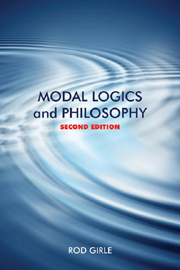Book contents
- Frontmatter
- Contents
- Preface
- Acknowledgements
- 1 Argument and modality
- Part 1 Formal systems
- 2 A simple modal logic
- 3 The normal modal logics
- 4 The non-normal modal logics
- 5 Natural deduction and axiomatics
- 6 Conditional logic
- 7 Modal predicate logics
- 8 Quantifiers and existence
- Part 2 Applications
- Answers
- Index
5 - Natural deduction and axiomatics
from Part 1 - Formal systems
- Frontmatter
- Contents
- Preface
- Acknowledgements
- 1 Argument and modality
- Part 1 Formal systems
- 2 A simple modal logic
- 3 The normal modal logics
- 4 The non-normal modal logics
- 5 Natural deduction and axiomatics
- 6 Conditional logic
- 7 Modal predicate logics
- 8 Quantifiers and existence
- Part 2 Applications
- Answers
- Index
Summary
Introduction
Modal logic has long been studied from a proof theoretic perspective. The three main kinds of proof theory are well represented in the literature: natural deduction, sequent systems, and axiomatic systems. We shall set out both natural deduction systems and axiomatic systems for propositional modal logics.
Since most of you will have met some sort of natural deduction system in introductory logic, we begin with natural deduction. We set out a Fitch style system. His are in Symbolic Logic: An Introduction (Fitch 1952). We then move to axiomatic systems.
Natural deduction
We assume that you are already familiar with a natural deduction system for propositional logic. There are several well known systems. Fitch's and Lemmon's are two of the most well known. We base our exposition on Fitch and Hughes and Cresswell. An introductory exposition is to be found in Fitch, Copi or Kahane.
We take it that we have the standard set of replacement rules. These include the commutativity, associativity and idempotence for both & and ∨; double negation and DeMorgan's laws; contraposition and exportation/ importation for ⊃; and the interdefinability of ⊃ and ∨, often called material implication.
We assume that there are at least the following inference rules: simplification, conjunction, disjunctive addition, disjunctive syllogism, modus ponens, modus tollens, hypothetical syllogism, conditional proof, and some form of reductio ad absurdum. A summary of these is to be found at the end of this chapter.
- Type
- Chapter
- Information
- Modal Logics and Philosophy , pp. 68 - 86Publisher: Acumen PublishingPrint publication year: 2009



